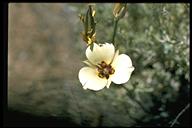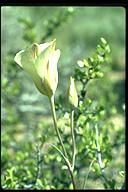

Sego Lily
Calochortus nuttallii Torr.
& Gray
A while tulip like flower with a triangular cup-shaped appearance. Flowers are few and showy, base of petals being white and marked with a crescent-shaped purple band or spot. Stands between 3 to 17 inches high with basal, slender, leaves that are usually shorter tan the stem. Blooms in June and early July. t has a cup-shaped flower on a single stem which are long and white sometimes shaded with lilac. In is found in high desert valleys from 5,000 to 9,000 feet in the Rocky Mountains. It is found throughout Southeastern Idaho.
Historic Food Use:
Important food to the Indians
and early settlers. It is credited with saving the life of many Mormon
settlers when crops were destroyed by crickets in 1848 and therefore was named the state flower of Utah. The whole plant is
edible and it can be used as a potherb. The seeds can be ground as as food
and bread may be made from the starchy meal. The flower buds eaten raw in a kind of salad. The thick-scaled bulbs
are a real delicacy having a crisp nutlike texture and the source of a good food
supply. The bulbs are washed and the other husk or coat removed. They can be
eaten raw with a pleasant starchy taste somewhat like a raw potato, or be fried
or baked.
Planting:
Requires a deep very well-drained fertile sandy soil in a warm sunny
position and must be kept dry from mid summer to late autumn. Bulbs
frequently divide after flowering, the bulblets taking 2 years to reach
flowering size. Division of the bulbs as soon as the foliage dies down.
